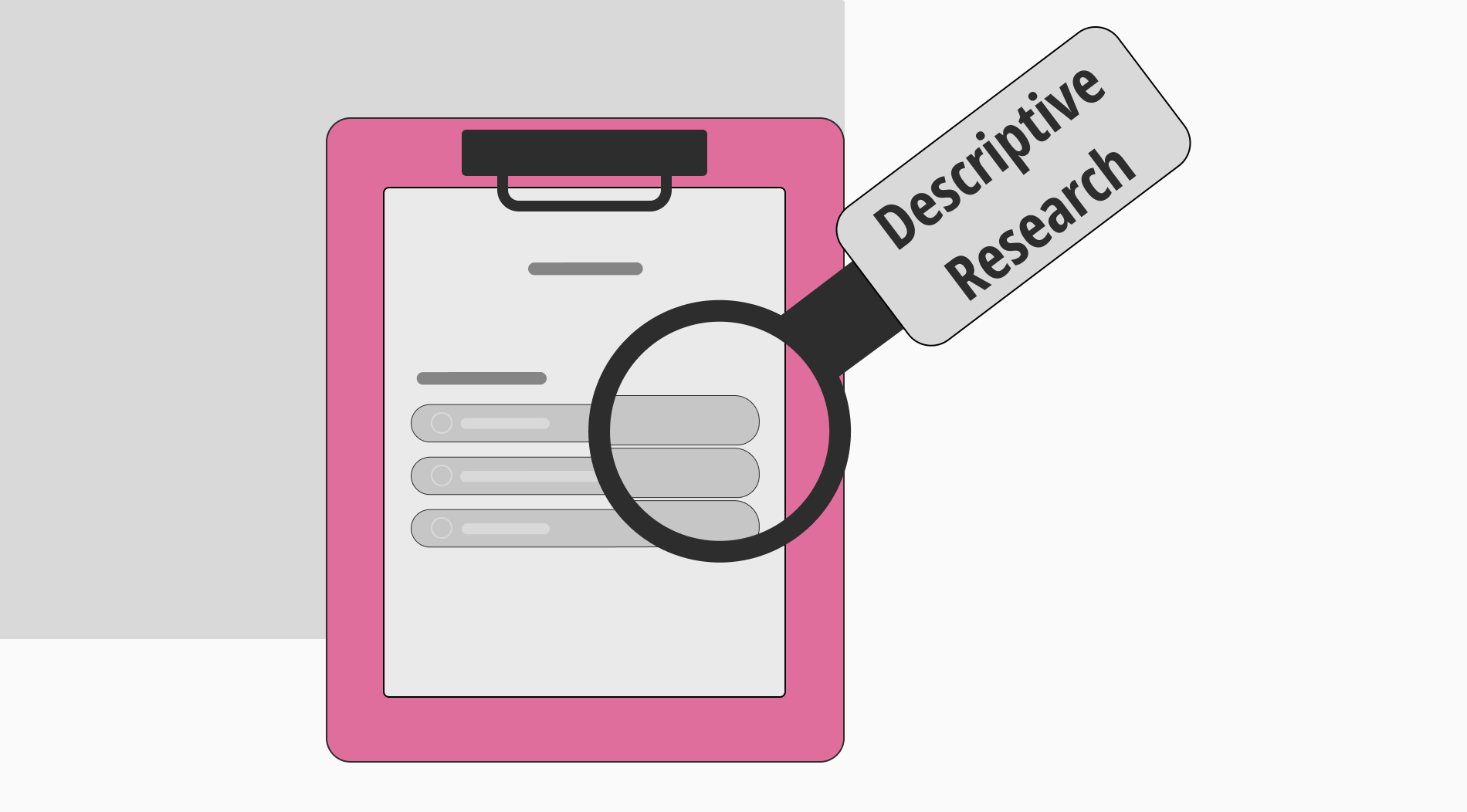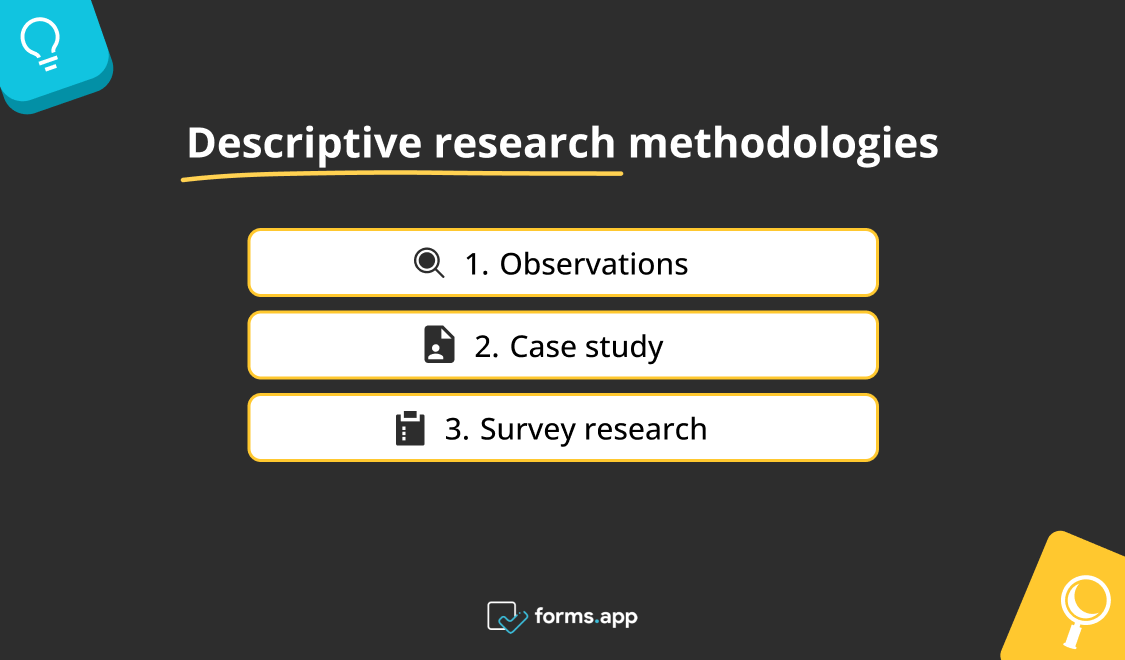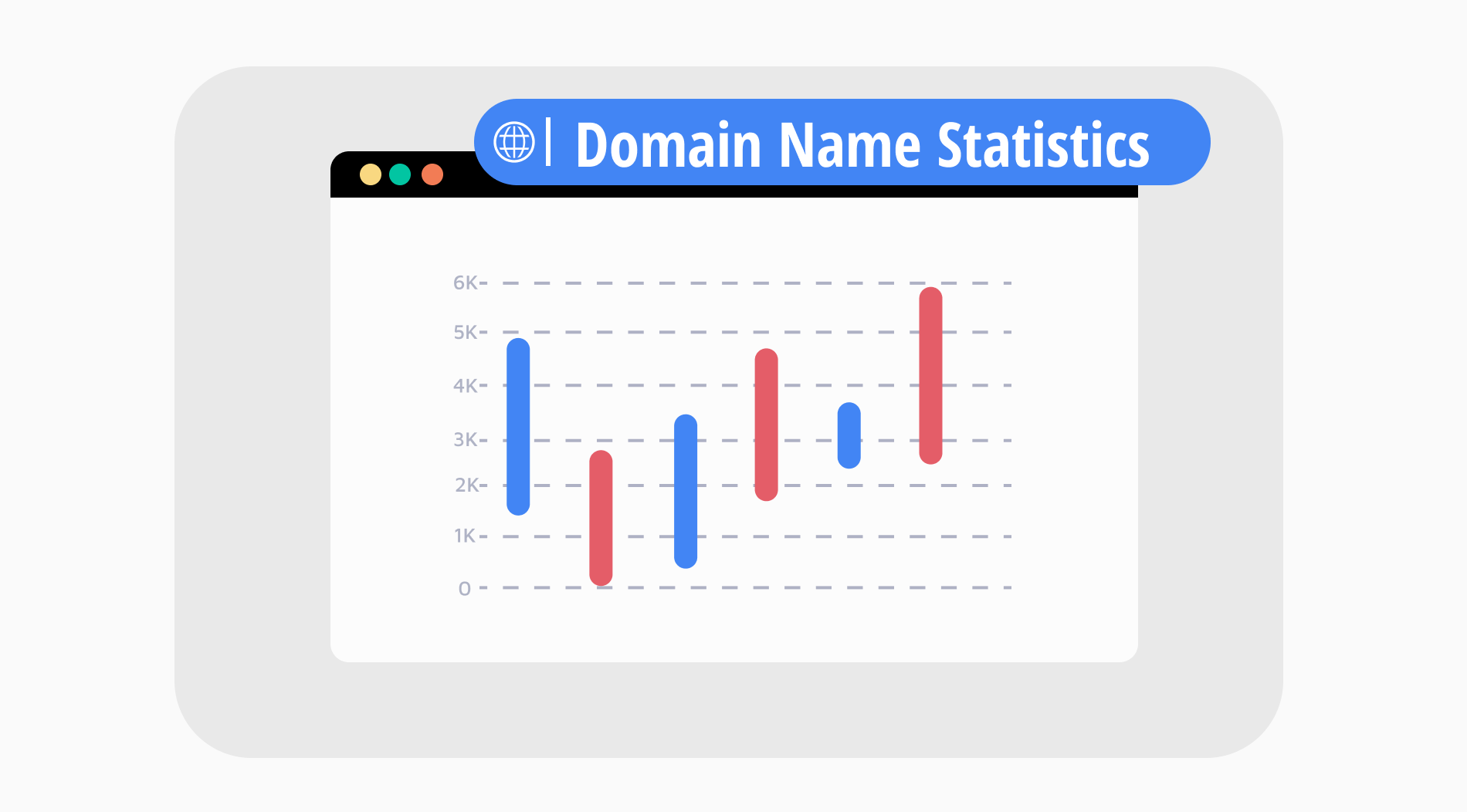
Being able to observe and describe your surroundings successfully is very crucial when you are doing a study. But what does it really mean? Let us give an example;
You are watching a schoolyard and observing the kids interact with one another. Then, you make comments about their ages, sexes, and playing patterns. You write down how many children there are and how many have blond hair, brown eyes, and stuff like that. In this scenario, you are “describing” them according to your observation.
Have this concept on a much bigger scale, and you have descriptive research. But why would a researcher need to do this research? Let us see what it means, when to do it, and some real-life examples.🔎
What is descriptive research?
Descriptive research is a type of research where researchers try to “describe” the characteristics of the problem, phenomenon, or subject.
The researcher studies the details and background information related to the subject. Therefore, this research type deals with the questions of what, when, and where and try to find answers to these questions.
However, it is important to keep in mind that this research type does not try to explore the cause-and-effect relationship of the aspects. So, this research type does not deal with questions of why and how.
When to use descriptive research?
A researcher can use descriptive research for numerous reasons. As with all the research types, the researcher should want to answer some questions. In this method, the questions are basically, “What are the elements that contribute to this phenomenon?” But let us make a list of reasons that may play a role in the researcher's mind. The researcher chooses to conduct descriptive research when he/she:
- Wants to understand a concept better than before. (This research method brings forward the hidden details and gives them a systematic form)
- Wishes to describe relationships between different concepts.
- Wants to explore patterns and trends.
- Wants to get into the core of the information for future studies.
- Decides to compare data from numerous sources.
- Wishes to explore the best approach for future studies.
Characteristics of descriptive research
Descriptive research is characterized by several key features, and these aspects differentiate it from other research types. Now, let us see a list of the main characteristics of descriptive research:
- It answers W questions. Meaning what, when, who, and where. They give concrete answers that are useful for the whole study.
- It gives qualitative and quantitative results. The results of descriptive research can be both numerical and open-ended.
- Makes way for future research. The results collected via descriptive research make a good start for future studies. The researcher can simply take what is on hand and build on it.
- It is conducted in natural settings. As natural observation and surveying are two of the great methods of descriptive research, they provide unbiased information. Let us say you want to test the accessibility and effectiveness of children's playgrounds; you can observe daily and survey the parents, etc.
- It can be used in many areas. From marketing, medicine, and education to psychology, the results of descriptive research can be used in any field.
Descriptive research methods

Descriptive research methodologies
In order to conduct descriptive research, the researchers can use one of the methods below or make a mix of all three. It depends on the researchers and the research problems. Now let us see the three descriptive research methods:
1. Observations
One of the best ways to collect real-life, accurate, and honest information about human behavior is through observations. The observational method is an essential part of descriptive research. There is no outside intervention to observations. However, the researcher can be part of the observation as an observer, participant as an observer, or a full participant.
2. Case study
A case study study is done by gathering a group of individuals as a sample group. The characteristics, details, and choices of this sample group are used to have a generalized idea to represent a bigger population. This generalization from a case study is actually risky as the data collected can be insufficient to make accurate predictions about larger groups.
3. Survey research
Surveys are where the researcher asks pre-determined questions to participants to collect information from them. The questions can be close-ended questions or open-ended questions where the answers are more free.
The survey can be done face-to-face, or it can be done online using a smart survey maker, such as forms.app. forms.app has more than 4000 ready-to-use templates, and it is free of charge.
Real-life examples of descriptive research
The study type of descriptive research can be used in many areas, including psychology, medicine, marketing, business, and education. It mostly depends on your objective. However, it is almost always smart to start with descriptive research. Now, here are some descriptive research examples:
Descriptive research example #1
A school branch that wants to open a daycare in the district can look at the demographics in the area. They can make a list of the number of families with kids ages 1-6 and the percentages of working mothers. If there are other competitors, they can make informed analyses about them as well. After all this studying of the region, the school branch can make an informed decision about whether or not to open a daycare in the area.
Descriptive research example #2
A restaurant owner wants to figure out what areas need to be improved and what kind of problems the visitors face daily. In order to collect detailed and systematic data about the subject, it is smart to use a survey, such as a customer satisfaction survey or a feedback survey. The survey can help identify specific areas that need improvements, such as food quality, service speed, or cleanliness concerns. The main focus of the study is obtaining customer feedback without manipulating variables.
Frequently asked questions about descriptive research
This research type has some similarities and differences with other research types and we have gathered some frequently asked questions about the subject. Let us see them:
The methods used in descriptive research are surveys and observation. For analytical research, the researcher has to use facts already available and analyze them to make a critical evaluation.
Descriptive research is usually described as quantitative research. The researcher doing a descriptive study defines the existing facts through observations and surveys. On the other hand, qualitative research aims to explore and answer the underlying meaning and context of subjects.
Yes, a study can be both analytical and descriptive. Researchers often use mixed methods to achieve a more comprehensive understanding of a concept. For example, particular research tries to analyze the characteristics of the youth population in a certain area (descriptive) and then examine how these characteristics are associated with alcohol abuse in the area (analytical).
The aim of descriptive research is to accurately and systematically obtain information to summarize events, subjects, and concepts. The data collected using types of descriptive research methods can be used to describe the characteristics, patterns, and relationships within a specific context.
Descriptive research is used to provide a detailed understanding of the elements of a specific subject, area, or concept in research. The findings of descriptive research work as a foundation for further investigations, hypothesis testing, and decision-making.
Key points to take away
A descriptive research method is an important step when starting a research project. The result of such data can give detailed information on the population or the area of the subject. After all, knowing what you are working with is a crucial element. Therefore, as descriptive research is a good start to a study, it also opens the doors for future projects. Here are some key elements to take away about descriptive research:
- Descriptive research does not explore cause-and-effect relations but rather answers the questions of what, who, and when.
- It is used to define details and explore patterns.
- Gives both qualitative and quantitative results.
- The methods that can be used when doing descriptive research are case studies, observations, and surveys.
- Gives a good foundation for future research.
In conclusion, descriptive research is about being able to make an analysis that answers qualitative and quantitative questions. In this article, we mentioned when to use this research type, its characteristics, research methods, examples, and frequently asked questions. For so much more and all your research needs, visit forms.app today!
Defne is a content writer at forms.app. She is also a translator specializing in literary translation. Defne loves reading, writing, and translating professionally and as a hobby. Her expertise lies in survey research, research methodologies, content writing, and translation.



 5 min read
5 min read

.jpg)